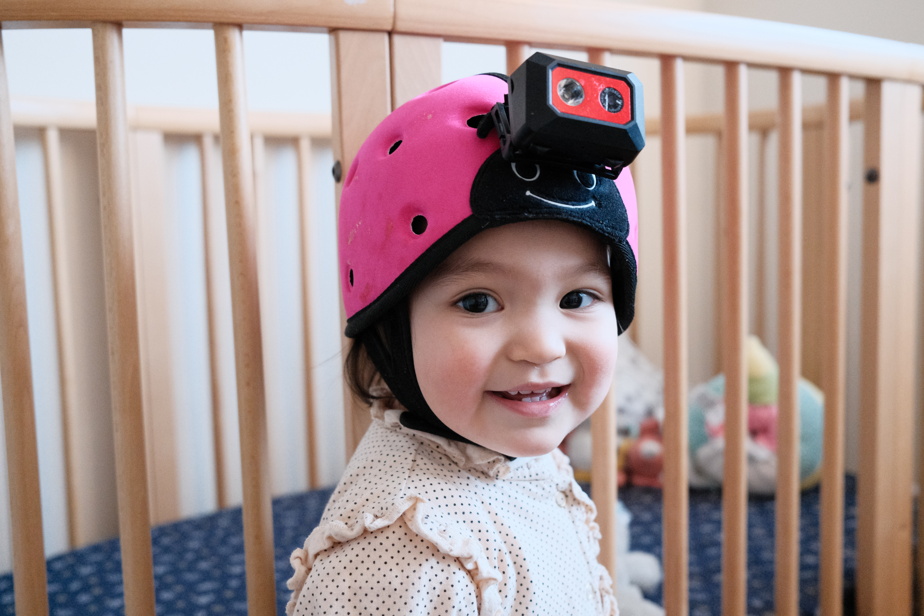To learn how to “speak,” artificial intelligence (AI) software like ChatGPT needs trillions of words, the equivalent of 100,000 years of human experience. However, babies learn to speak at 1 or 2 years old. Researchers are beginning to understand why.
“Babies have a lot of visual cues to understand language,” explains Brenden Lake, a psychologist at New York University who has just published a study on the subject in the journal Nature. “They understand the different categories of objects and actions before they can speak. It accelerates language development. »

PHOTO SUPPLIED BY BRENDEN LAKE
The kid who took the videos analyzed by Brenden Lake
Mr. Lake is working on generative AI software that would create text, learning like babies. To achieve this, its algorithm analyzes videos collected by young children who wear a helmet equipped with a camera. This films and records several hours of images per day.
What will be the potential applications, aside from easier-to-train creative AI software? “We can think of help for children with language difficulties,” says Mr. Lake. Or creative AI for minority languages, less well served today. We could also more easily document languages in danger of disappearing, and even create grammars to facilitate their learning. »
Mr. Lake estimates that these advances could occur in less than 10 years.

PHOTO SUPPLIED BY LINDA SMITH
Linda Smith with one of the small subjects of her study
Learn with the eyes
This field of study originated with Linda Smith, a psychologist at Indiana University, who first postulated, 20 years ago, that babies learn to speak with their eyes as well as their ears.
“We’ve known for a long time that babies don’t learn to speak just with their hearing, by hearing words repeatedly,” says M.me Smith. The words they hear from their parents are simply too few. There have been many language theorists, like Noam Chomsky, who have thought about this question. I decided to concretely measure the visual and auditory stimuli to which babies are exposed. »
Mme Smith believes that babies learn that there are “categories” of objects along with language. “When the ability to speak explodes, the categories are already well formed. For example, babies know what pizza looks like long before they say the word. »
Mme Smith believes that the language learning algorithm developed by Mr. Lake is a first step. “But it remains statistical, and above all, it does not include a crucial parameter: the actions that the baby makes to seek other stimuli, by moving or moving his eyes. » She expressed these caveats in a commentary which accompanied Mr. Lake’s study in Nature.
One of M’s videosme Smith illustrates his point well. A 4-month-old baby is lying under an arch with hanging toys, but his head is turned toward the top of the arch, toward his mother’s face, so we can’t see the moving toys, presumably because the baby hits them with his little handcuffs.

PHOTO SUPPLIED BY LINDA SMITH
Linda Smith with one of the small subjects of her study
Eye movements
Current technology limits researchers’ observations. “Babies can move their eyes without moving their heads, so they can look at objects without the camera noticing,” says M.me Smith. This is particularly a problem outdoors. »
Another dimension that complicates video analysis is the development of visual sensitivity. “The ability to see low contrast increases with age,” says M.me Smith. I’m about to publish an initial analysis of this problem. »
The videos Mr. Lake used, recorded by another researcher – Michael Frank of Stanford University – followed a baby from 6 months to 2 years old. “Before 6 months, the baby’s head is not strong enough to support the weight of the helmet and camera. »
-

PHOTO SUPPLIED BY LINDA SMITH
The lightweight cameras used by Linda Smith can be worn from 2 months old.
-

PHOTO SUPPLIED BY LINDA SMITH
The lightweight cameras used by Linda Smith can be worn from 2 months old.
-

PHOTO SUPPLIED BY LINDA SMITH
The lightweight cameras used by Linda Smith can be worn from 2 months old.
-

PHOTO SUPPLIED BY LINDA SMITH
Some of the images taken from Linda Smith’s videos
1/4
Mme Smith uses a lighter camera that can be attached to a hat, which explains why she has footage from as young as 2 months old.
“We have a compromise to make between the resolution and battery life of the camera, and its weight,” says Mr. Frank, whose BabyView project was launched around ten years ago. “We used a GoPro, which makes it easier to interact with participating parents. It is certain that technological advances in cameras will improve data collection in the years to come. »

PHOTO SUPPLIED BY BRENDEN LAKE
Brenden Lake’s daughter also participated in Michael Frank’s study.
Mr. Lake’s daughter also participated in BabyView.
Learn more
-
- 4662
- Number of words heard before age 5 by an American child whose parents never read books to them. During the same period, he will hear 296,660 words if his parents read him one book per day and 1.5 million words if they read him five books per day.
Source : Journal of Developmental and Behavioral Pediatrics
